Deconstructing Identity: An Analysis of Media and Haraway's Cyborg
VerifiedAdded on 2023/06/03
|10
|3219
|70
Essay
AI Summary
This essay explores the influence of media on individual identity, primarily through an analysis of Donna Haraway's "A Cyborg Manifesto." It discusses how traditional binaries like male/female and human/animal are deconstructed in the context of technology and modern science. The essay examines Haraway's concept of the cyborg as a hybrid entity, challenging established notions of identity shaped by religion, society, and feminist theory. Furthermore, it considers the work of scientists like Stelarc and Neil Harbisson, whose experiments defy traditional human boundaries, ultimately arguing that identity should be based on individual consciousness and emotions rather than conventional social constructs. Desklib offers a wealth of similar essays and study resources for students.
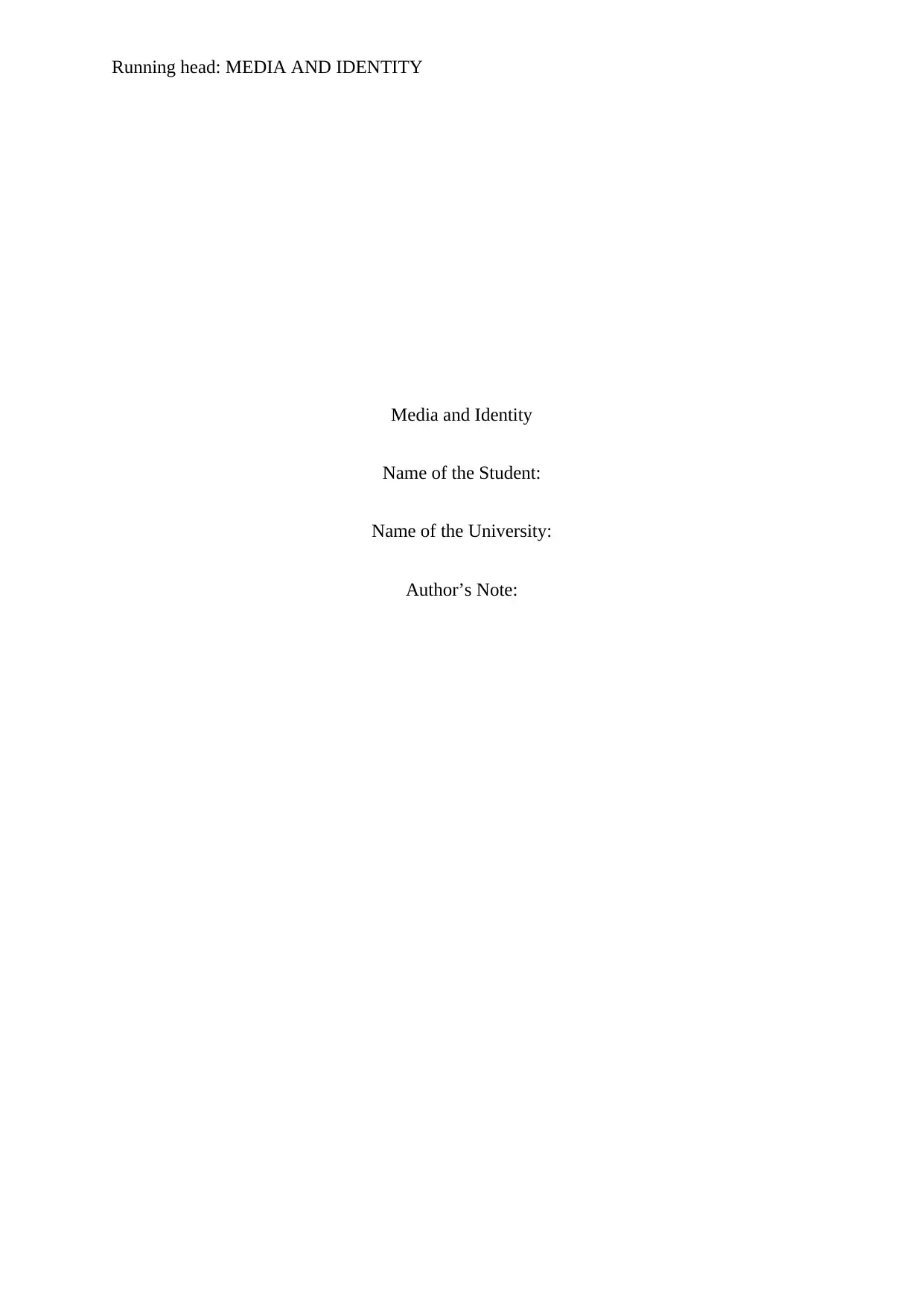
Running head: MEDIA AND IDENTITY
Media and Identity
Name of the Student:
Name of the University:
Author’s Note:
Media and Identity
Name of the Student:
Name of the University:
Author’s Note:
Paraphrase This Document
Need a fresh take? Get an instant paraphrase of this document with our AI Paraphraser
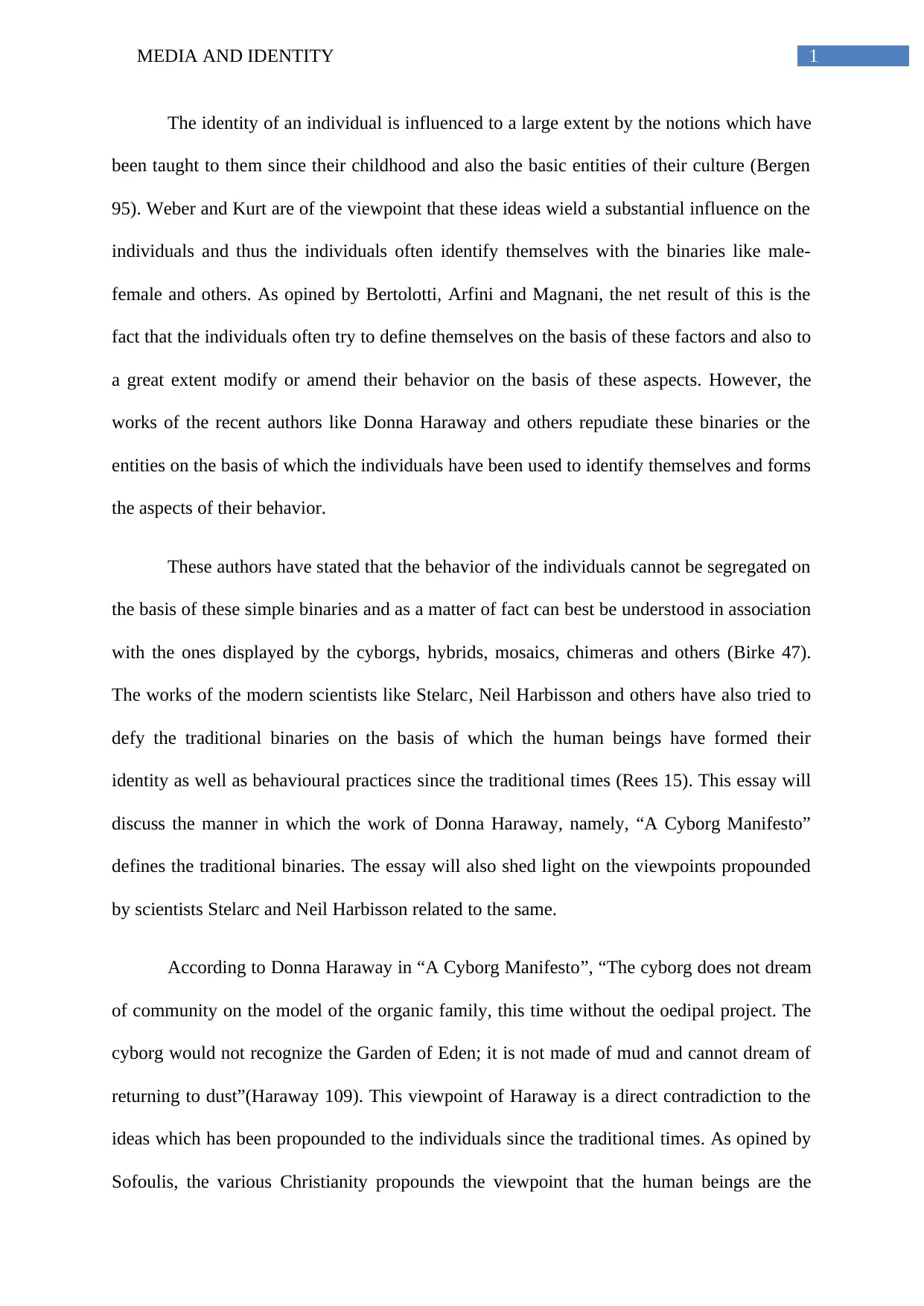
1MEDIA AND IDENTITY
The identity of an individual is influenced to a large extent by the notions which have
been taught to them since their childhood and also the basic entities of their culture (Bergen
95). Weber and Kurt are of the viewpoint that these ideas wield a substantial influence on the
individuals and thus the individuals often identify themselves with the binaries like male-
female and others. As opined by Bertolotti, Arfini and Magnani, the net result of this is the
fact that the individuals often try to define themselves on the basis of these factors and also to
a great extent modify or amend their behavior on the basis of these aspects. However, the
works of the recent authors like Donna Haraway and others repudiate these binaries or the
entities on the basis of which the individuals have been used to identify themselves and forms
the aspects of their behavior.
These authors have stated that the behavior of the individuals cannot be segregated on
the basis of these simple binaries and as a matter of fact can best be understood in association
with the ones displayed by the cyborgs, hybrids, mosaics, chimeras and others (Birke 47).
The works of the modern scientists like Stelarc, Neil Harbisson and others have also tried to
defy the traditional binaries on the basis of which the human beings have formed their
identity as well as behavioural practices since the traditional times (Rees 15). This essay will
discuss the manner in which the work of Donna Haraway, namely, “A Cyborg Manifesto”
defines the traditional binaries. The essay will also shed light on the viewpoints propounded
by scientists Stelarc and Neil Harbisson related to the same.
According to Donna Haraway in “A Cyborg Manifesto”, “The cyborg does not dream
of community on the model of the organic family, this time without the oedipal project. The
cyborg would not recognize the Garden of Eden; it is not made of mud and cannot dream of
returning to dust”(Haraway 109). This viewpoint of Haraway is a direct contradiction to the
ideas which has been propounded to the individuals since the traditional times. As opined by
Sofoulis, the various Christianity propounds the viewpoint that the human beings are the
The identity of an individual is influenced to a large extent by the notions which have
been taught to them since their childhood and also the basic entities of their culture (Bergen
95). Weber and Kurt are of the viewpoint that these ideas wield a substantial influence on the
individuals and thus the individuals often identify themselves with the binaries like male-
female and others. As opined by Bertolotti, Arfini and Magnani, the net result of this is the
fact that the individuals often try to define themselves on the basis of these factors and also to
a great extent modify or amend their behavior on the basis of these aspects. However, the
works of the recent authors like Donna Haraway and others repudiate these binaries or the
entities on the basis of which the individuals have been used to identify themselves and forms
the aspects of their behavior.
These authors have stated that the behavior of the individuals cannot be segregated on
the basis of these simple binaries and as a matter of fact can best be understood in association
with the ones displayed by the cyborgs, hybrids, mosaics, chimeras and others (Birke 47).
The works of the modern scientists like Stelarc, Neil Harbisson and others have also tried to
defy the traditional binaries on the basis of which the human beings have formed their
identity as well as behavioural practices since the traditional times (Rees 15). This essay will
discuss the manner in which the work of Donna Haraway, namely, “A Cyborg Manifesto”
defines the traditional binaries. The essay will also shed light on the viewpoints propounded
by scientists Stelarc and Neil Harbisson related to the same.
According to Donna Haraway in “A Cyborg Manifesto”, “The cyborg does not dream
of community on the model of the organic family, this time without the oedipal project. The
cyborg would not recognize the Garden of Eden; it is not made of mud and cannot dream of
returning to dust”(Haraway 109). This viewpoint of Haraway is a direct contradiction to the
ideas which has been propounded to the individuals since the traditional times. As opined by
Sofoulis, the various Christianity propounds the viewpoint that the human beings are the
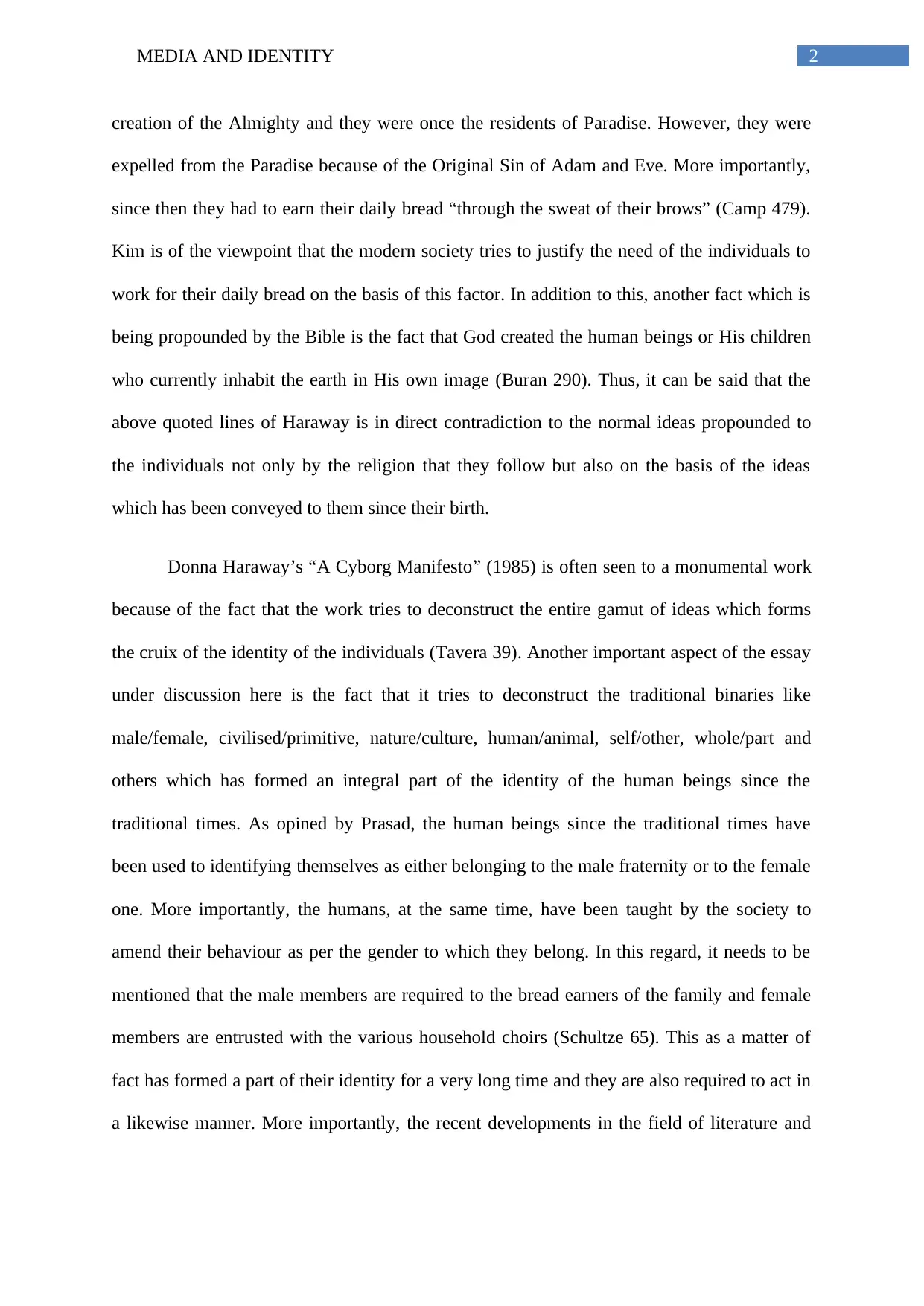
2MEDIA AND IDENTITY
creation of the Almighty and they were once the residents of Paradise. However, they were
expelled from the Paradise because of the Original Sin of Adam and Eve. More importantly,
since then they had to earn their daily bread “through the sweat of their brows” (Camp 479).
Kim is of the viewpoint that the modern society tries to justify the need of the individuals to
work for their daily bread on the basis of this factor. In addition to this, another fact which is
being propounded by the Bible is the fact that God created the human beings or His children
who currently inhabit the earth in His own image (Buran 290). Thus, it can be said that the
above quoted lines of Haraway is in direct contradiction to the normal ideas propounded to
the individuals not only by the religion that they follow but also on the basis of the ideas
which has been conveyed to them since their birth.
Donna Haraway’s “A Cyborg Manifesto” (1985) is often seen to a monumental work
because of the fact that the work tries to deconstruct the entire gamut of ideas which forms
the cruix of the identity of the individuals (Tavera 39). Another important aspect of the essay
under discussion here is the fact that it tries to deconstruct the traditional binaries like
male/female, civilised/primitive, nature/culture, human/animal, self/other, whole/part and
others which has formed an integral part of the identity of the human beings since the
traditional times. As opined by Prasad, the human beings since the traditional times have
been used to identifying themselves as either belonging to the male fraternity or to the female
one. More importantly, the humans, at the same time, have been taught by the society to
amend their behaviour as per the gender to which they belong. In this regard, it needs to be
mentioned that the male members are required to the bread earners of the family and female
members are entrusted with the various household choirs (Schultze 65). This as a matter of
fact has formed a part of their identity for a very long time and they are also required to act in
a likewise manner. More importantly, the recent developments in the field of literature and
creation of the Almighty and they were once the residents of Paradise. However, they were
expelled from the Paradise because of the Original Sin of Adam and Eve. More importantly,
since then they had to earn their daily bread “through the sweat of their brows” (Camp 479).
Kim is of the viewpoint that the modern society tries to justify the need of the individuals to
work for their daily bread on the basis of this factor. In addition to this, another fact which is
being propounded by the Bible is the fact that God created the human beings or His children
who currently inhabit the earth in His own image (Buran 290). Thus, it can be said that the
above quoted lines of Haraway is in direct contradiction to the normal ideas propounded to
the individuals not only by the religion that they follow but also on the basis of the ideas
which has been conveyed to them since their birth.
Donna Haraway’s “A Cyborg Manifesto” (1985) is often seen to a monumental work
because of the fact that the work tries to deconstruct the entire gamut of ideas which forms
the cruix of the identity of the individuals (Tavera 39). Another important aspect of the essay
under discussion here is the fact that it tries to deconstruct the traditional binaries like
male/female, civilised/primitive, nature/culture, human/animal, self/other, whole/part and
others which has formed an integral part of the identity of the human beings since the
traditional times. As opined by Prasad, the human beings since the traditional times have
been used to identifying themselves as either belonging to the male fraternity or to the female
one. More importantly, the humans, at the same time, have been taught by the society to
amend their behaviour as per the gender to which they belong. In this regard, it needs to be
mentioned that the male members are required to the bread earners of the family and female
members are entrusted with the various household choirs (Schultze 65). This as a matter of
fact has formed a part of their identity for a very long time and they are also required to act in
a likewise manner. More importantly, the recent developments in the field of literature and
⊘ This is a preview!⊘
Do you want full access?
Subscribe today to unlock all pages.

Trusted by 1+ million students worldwide
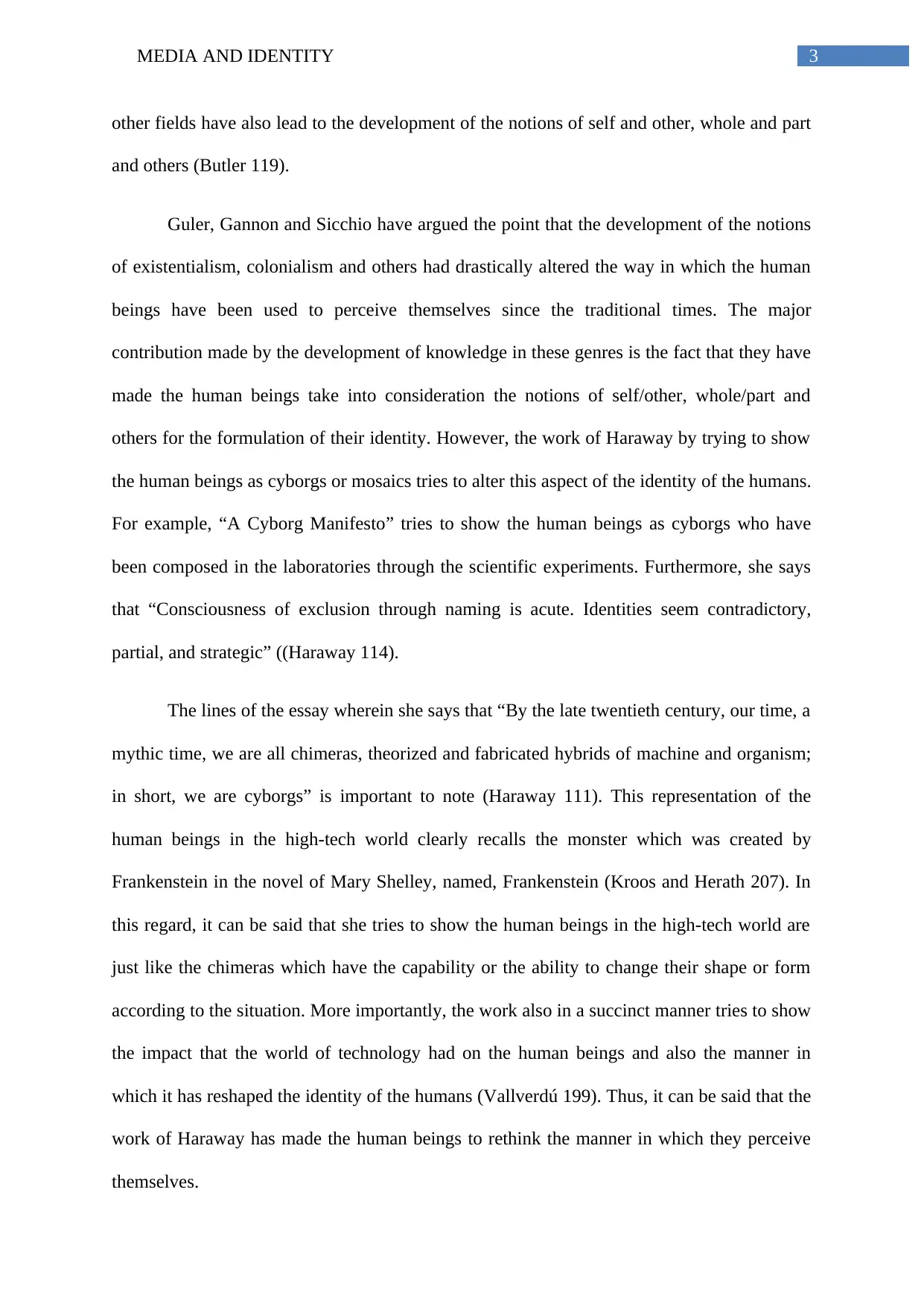
3MEDIA AND IDENTITY
other fields have also lead to the development of the notions of self and other, whole and part
and others (Butler 119).
Guler, Gannon and Sicchio have argued the point that the development of the notions
of existentialism, colonialism and others had drastically altered the way in which the human
beings have been used to perceive themselves since the traditional times. The major
contribution made by the development of knowledge in these genres is the fact that they have
made the human beings take into consideration the notions of self/other, whole/part and
others for the formulation of their identity. However, the work of Haraway by trying to show
the human beings as cyborgs or mosaics tries to alter this aspect of the identity of the humans.
For example, “A Cyborg Manifesto” tries to show the human beings as cyborgs who have
been composed in the laboratories through the scientific experiments. Furthermore, she says
that “Consciousness of exclusion through naming is acute. Identities seem contradictory,
partial, and strategic” ((Haraway 114).
The lines of the essay wherein she says that “By the late twentieth century, our time, a
mythic time, we are all chimeras, theorized and fabricated hybrids of machine and organism;
in short, we are cyborgs” is important to note (Haraway 111). This representation of the
human beings in the high-tech world clearly recalls the monster which was created by
Frankenstein in the novel of Mary Shelley, named, Frankenstein (Kroos and Herath 207). In
this regard, it can be said that she tries to show the human beings in the high-tech world are
just like the chimeras which have the capability or the ability to change their shape or form
according to the situation. More importantly, the work also in a succinct manner tries to show
the impact that the world of technology had on the human beings and also the manner in
which it has reshaped the identity of the humans (Vallverdú 199). Thus, it can be said that the
work of Haraway has made the human beings to rethink the manner in which they perceive
themselves.
other fields have also lead to the development of the notions of self and other, whole and part
and others (Butler 119).
Guler, Gannon and Sicchio have argued the point that the development of the notions
of existentialism, colonialism and others had drastically altered the way in which the human
beings have been used to perceive themselves since the traditional times. The major
contribution made by the development of knowledge in these genres is the fact that they have
made the human beings take into consideration the notions of self/other, whole/part and
others for the formulation of their identity. However, the work of Haraway by trying to show
the human beings as cyborgs or mosaics tries to alter this aspect of the identity of the humans.
For example, “A Cyborg Manifesto” tries to show the human beings as cyborgs who have
been composed in the laboratories through the scientific experiments. Furthermore, she says
that “Consciousness of exclusion through naming is acute. Identities seem contradictory,
partial, and strategic” ((Haraway 114).
The lines of the essay wherein she says that “By the late twentieth century, our time, a
mythic time, we are all chimeras, theorized and fabricated hybrids of machine and organism;
in short, we are cyborgs” is important to note (Haraway 111). This representation of the
human beings in the high-tech world clearly recalls the monster which was created by
Frankenstein in the novel of Mary Shelley, named, Frankenstein (Kroos and Herath 207). In
this regard, it can be said that she tries to show the human beings in the high-tech world are
just like the chimeras which have the capability or the ability to change their shape or form
according to the situation. More importantly, the work also in a succinct manner tries to show
the impact that the world of technology had on the human beings and also the manner in
which it has reshaped the identity of the humans (Vallverdú 199). Thus, it can be said that the
work of Haraway has made the human beings to rethink the manner in which they perceive
themselves.
Paraphrase This Document
Need a fresh take? Get an instant paraphrase of this document with our AI Paraphraser
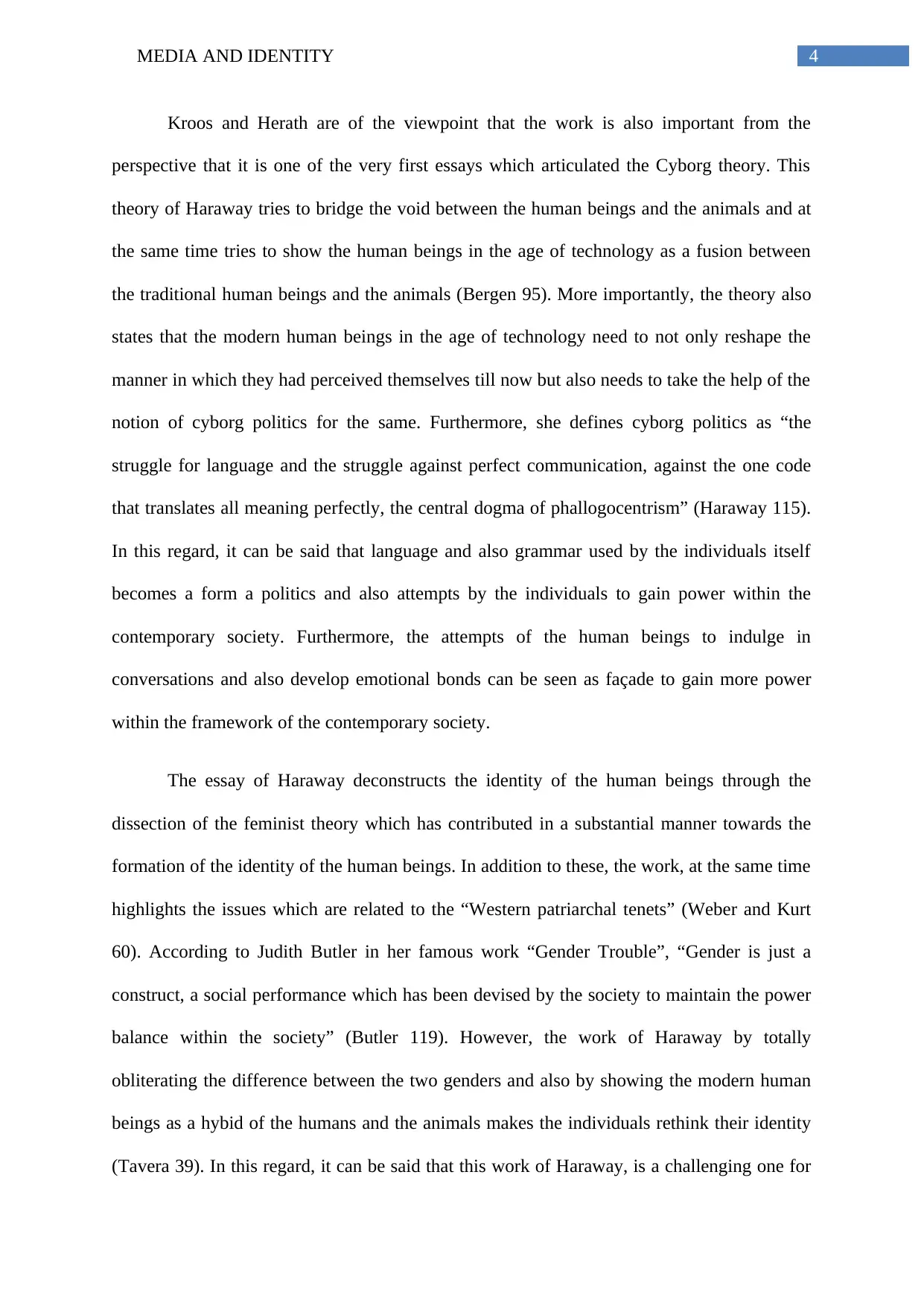
4MEDIA AND IDENTITY
Kroos and Herath are of the viewpoint that the work is also important from the
perspective that it is one of the very first essays which articulated the Cyborg theory. This
theory of Haraway tries to bridge the void between the human beings and the animals and at
the same time tries to show the human beings in the age of technology as a fusion between
the traditional human beings and the animals (Bergen 95). More importantly, the theory also
states that the modern human beings in the age of technology need to not only reshape the
manner in which they had perceived themselves till now but also needs to take the help of the
notion of cyborg politics for the same. Furthermore, she defines cyborg politics as “the
struggle for language and the struggle against perfect communication, against the one code
that translates all meaning perfectly, the central dogma of phallogocentrism” (Haraway 115).
In this regard, it can be said that language and also grammar used by the individuals itself
becomes a form a politics and also attempts by the individuals to gain power within the
contemporary society. Furthermore, the attempts of the human beings to indulge in
conversations and also develop emotional bonds can be seen as façade to gain more power
within the framework of the contemporary society.
The essay of Haraway deconstructs the identity of the human beings through the
dissection of the feminist theory which has contributed in a substantial manner towards the
formation of the identity of the human beings. In addition to these, the work, at the same time
highlights the issues which are related to the “Western patriarchal tenets” (Weber and Kurt
60). According to Judith Butler in her famous work “Gender Trouble”, “Gender is just a
construct, a social performance which has been devised by the society to maintain the power
balance within the society” (Butler 119). However, the work of Haraway by totally
obliterating the difference between the two genders and also by showing the modern human
beings as a hybid of the humans and the animals makes the individuals rethink their identity
(Tavera 39). In this regard, it can be said that this work of Haraway, is a challenging one for
Kroos and Herath are of the viewpoint that the work is also important from the
perspective that it is one of the very first essays which articulated the Cyborg theory. This
theory of Haraway tries to bridge the void between the human beings and the animals and at
the same time tries to show the human beings in the age of technology as a fusion between
the traditional human beings and the animals (Bergen 95). More importantly, the theory also
states that the modern human beings in the age of technology need to not only reshape the
manner in which they had perceived themselves till now but also needs to take the help of the
notion of cyborg politics for the same. Furthermore, she defines cyborg politics as “the
struggle for language and the struggle against perfect communication, against the one code
that translates all meaning perfectly, the central dogma of phallogocentrism” (Haraway 115).
In this regard, it can be said that language and also grammar used by the individuals itself
becomes a form a politics and also attempts by the individuals to gain power within the
contemporary society. Furthermore, the attempts of the human beings to indulge in
conversations and also develop emotional bonds can be seen as façade to gain more power
within the framework of the contemporary society.
The essay of Haraway deconstructs the identity of the human beings through the
dissection of the feminist theory which has contributed in a substantial manner towards the
formation of the identity of the human beings. In addition to these, the work, at the same time
highlights the issues which are related to the “Western patriarchal tenets” (Weber and Kurt
60). According to Judith Butler in her famous work “Gender Trouble”, “Gender is just a
construct, a social performance which has been devised by the society to maintain the power
balance within the society” (Butler 119). However, the work of Haraway by totally
obliterating the difference between the two genders and also by showing the modern human
beings as a hybid of the humans and the animals makes the individuals rethink their identity
(Tavera 39). In this regard, it can be said that this work of Haraway, is a challenging one for
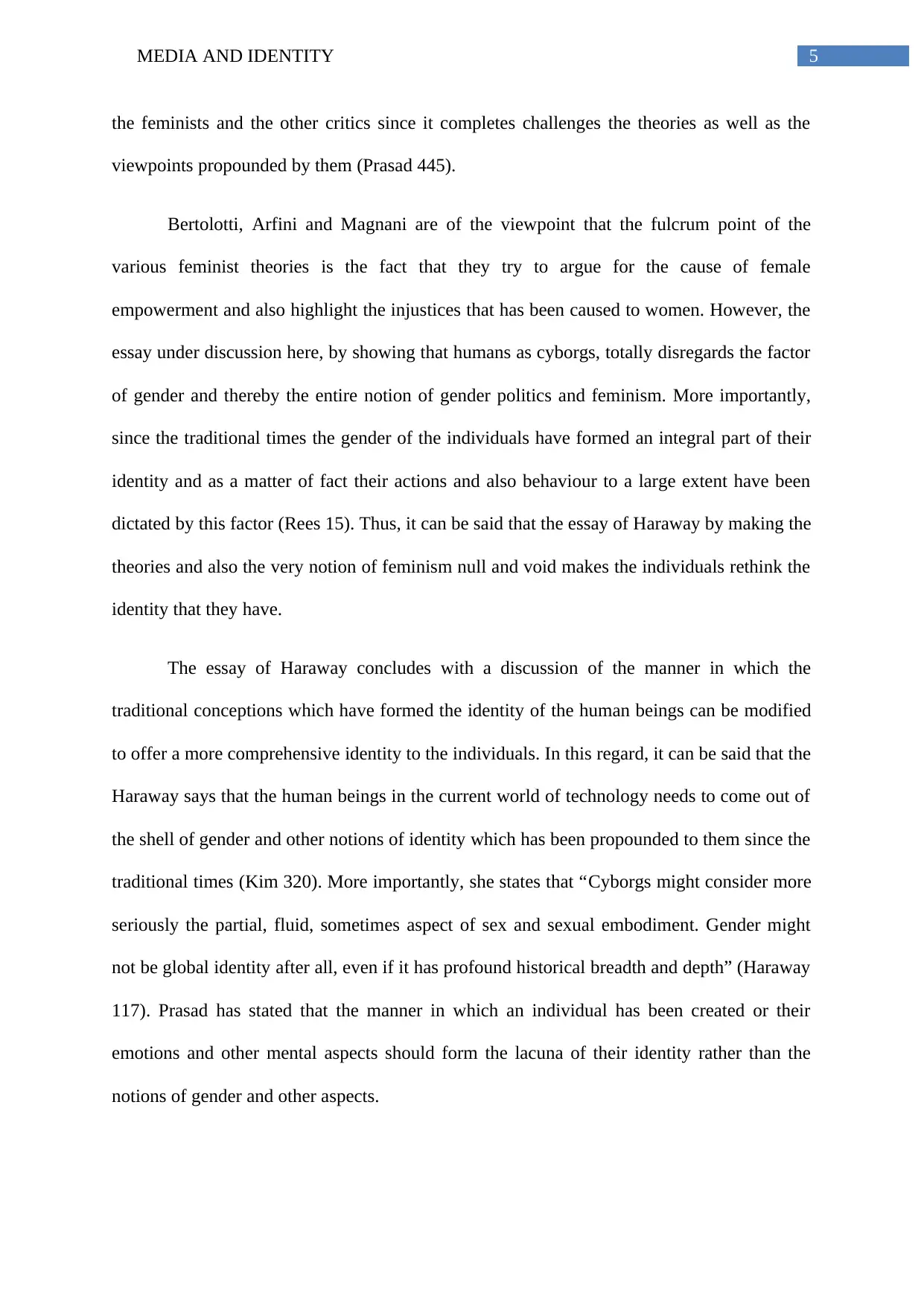
5MEDIA AND IDENTITY
the feminists and the other critics since it completes challenges the theories as well as the
viewpoints propounded by them (Prasad 445).
Bertolotti, Arfini and Magnani are of the viewpoint that the fulcrum point of the
various feminist theories is the fact that they try to argue for the cause of female
empowerment and also highlight the injustices that has been caused to women. However, the
essay under discussion here, by showing that humans as cyborgs, totally disregards the factor
of gender and thereby the entire notion of gender politics and feminism. More importantly,
since the traditional times the gender of the individuals have formed an integral part of their
identity and as a matter of fact their actions and also behaviour to a large extent have been
dictated by this factor (Rees 15). Thus, it can be said that the essay of Haraway by making the
theories and also the very notion of feminism null and void makes the individuals rethink the
identity that they have.
The essay of Haraway concludes with a discussion of the manner in which the
traditional conceptions which have formed the identity of the human beings can be modified
to offer a more comprehensive identity to the individuals. In this regard, it can be said that the
Haraway says that the human beings in the current world of technology needs to come out of
the shell of gender and other notions of identity which has been propounded to them since the
traditional times (Kim 320). More importantly, she states that “Cyborgs might consider more
seriously the partial, fluid, sometimes aspect of sex and sexual embodiment. Gender might
not be global identity after all, even if it has profound historical breadth and depth” (Haraway
117). Prasad has stated that the manner in which an individual has been created or their
emotions and other mental aspects should form the lacuna of their identity rather than the
notions of gender and other aspects.
the feminists and the other critics since it completes challenges the theories as well as the
viewpoints propounded by them (Prasad 445).
Bertolotti, Arfini and Magnani are of the viewpoint that the fulcrum point of the
various feminist theories is the fact that they try to argue for the cause of female
empowerment and also highlight the injustices that has been caused to women. However, the
essay under discussion here, by showing that humans as cyborgs, totally disregards the factor
of gender and thereby the entire notion of gender politics and feminism. More importantly,
since the traditional times the gender of the individuals have formed an integral part of their
identity and as a matter of fact their actions and also behaviour to a large extent have been
dictated by this factor (Rees 15). Thus, it can be said that the essay of Haraway by making the
theories and also the very notion of feminism null and void makes the individuals rethink the
identity that they have.
The essay of Haraway concludes with a discussion of the manner in which the
traditional conceptions which have formed the identity of the human beings can be modified
to offer a more comprehensive identity to the individuals. In this regard, it can be said that the
Haraway says that the human beings in the current world of technology needs to come out of
the shell of gender and other notions of identity which has been propounded to them since the
traditional times (Kim 320). More importantly, she states that “Cyborgs might consider more
seriously the partial, fluid, sometimes aspect of sex and sexual embodiment. Gender might
not be global identity after all, even if it has profound historical breadth and depth” (Haraway
117). Prasad has stated that the manner in which an individual has been created or their
emotions and other mental aspects should form the lacuna of their identity rather than the
notions of gender and other aspects.
⊘ This is a preview!⊘
Do you want full access?
Subscribe today to unlock all pages.

Trusted by 1+ million students worldwide
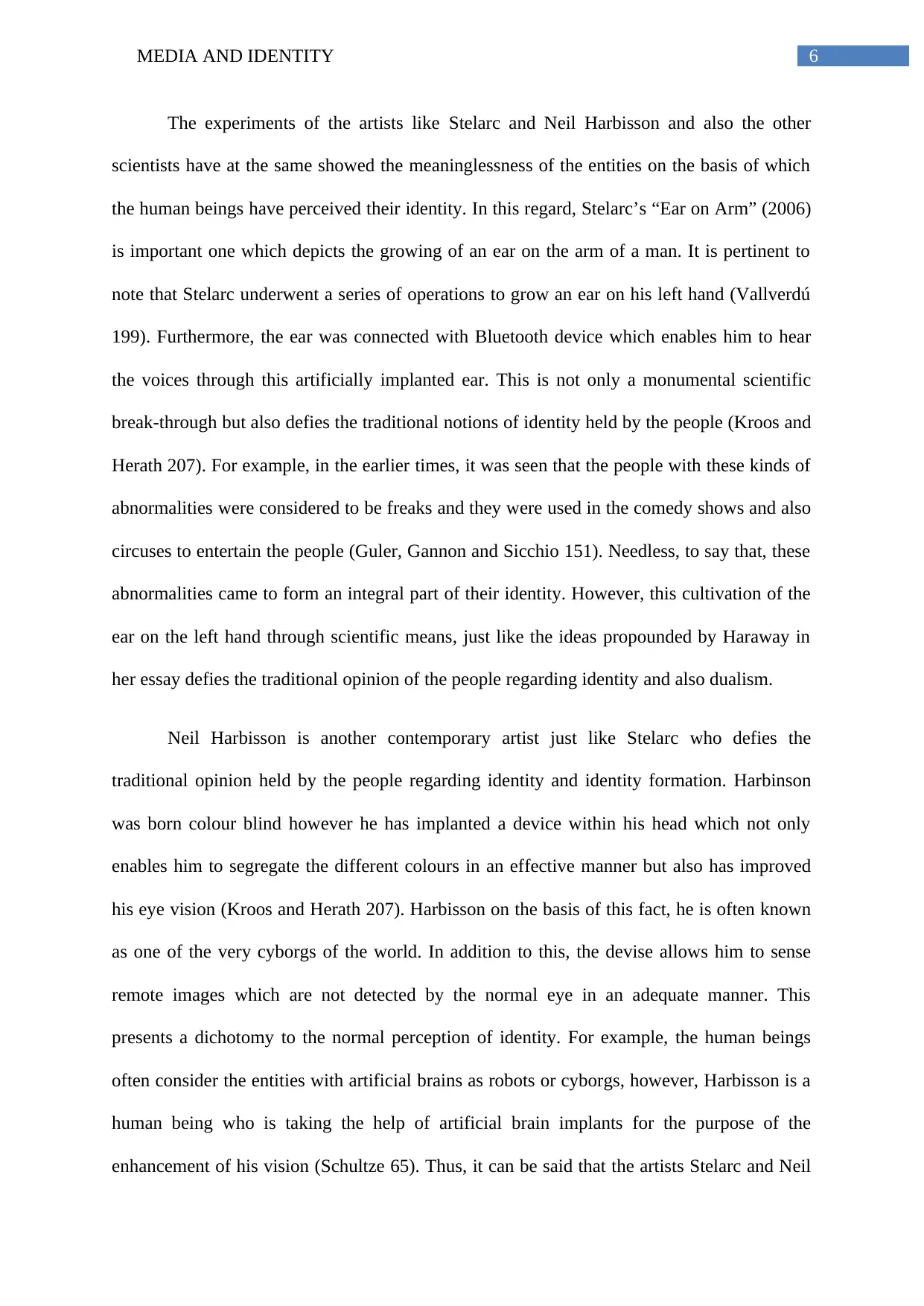
6MEDIA AND IDENTITY
The experiments of the artists like Stelarc and Neil Harbisson and also the other
scientists have at the same showed the meaninglessness of the entities on the basis of which
the human beings have perceived their identity. In this regard, Stelarc’s “Ear on Arm” (2006)
is important one which depicts the growing of an ear on the arm of a man. It is pertinent to
note that Stelarc underwent a series of operations to grow an ear on his left hand (Vallverdú
199). Furthermore, the ear was connected with Bluetooth device which enables him to hear
the voices through this artificially implanted ear. This is not only a monumental scientific
break-through but also defies the traditional notions of identity held by the people (Kroos and
Herath 207). For example, in the earlier times, it was seen that the people with these kinds of
abnormalities were considered to be freaks and they were used in the comedy shows and also
circuses to entertain the people (Guler, Gannon and Sicchio 151). Needless, to say that, these
abnormalities came to form an integral part of their identity. However, this cultivation of the
ear on the left hand through scientific means, just like the ideas propounded by Haraway in
her essay defies the traditional opinion of the people regarding identity and also dualism.
Neil Harbisson is another contemporary artist just like Stelarc who defies the
traditional opinion held by the people regarding identity and identity formation. Harbinson
was born colour blind however he has implanted a device within his head which not only
enables him to segregate the different colours in an effective manner but also has improved
his eye vision (Kroos and Herath 207). Harbisson on the basis of this fact, he is often known
as one of the very cyborgs of the world. In addition to this, the devise allows him to sense
remote images which are not detected by the normal eye in an adequate manner. This
presents a dichotomy to the normal perception of identity. For example, the human beings
often consider the entities with artificial brains as robots or cyborgs, however, Harbisson is a
human being who is taking the help of artificial brain implants for the purpose of the
enhancement of his vision (Schultze 65). Thus, it can be said that the artists Stelarc and Neil
The experiments of the artists like Stelarc and Neil Harbisson and also the other
scientists have at the same showed the meaninglessness of the entities on the basis of which
the human beings have perceived their identity. In this regard, Stelarc’s “Ear on Arm” (2006)
is important one which depicts the growing of an ear on the arm of a man. It is pertinent to
note that Stelarc underwent a series of operations to grow an ear on his left hand (Vallverdú
199). Furthermore, the ear was connected with Bluetooth device which enables him to hear
the voices through this artificially implanted ear. This is not only a monumental scientific
break-through but also defies the traditional notions of identity held by the people (Kroos and
Herath 207). For example, in the earlier times, it was seen that the people with these kinds of
abnormalities were considered to be freaks and they were used in the comedy shows and also
circuses to entertain the people (Guler, Gannon and Sicchio 151). Needless, to say that, these
abnormalities came to form an integral part of their identity. However, this cultivation of the
ear on the left hand through scientific means, just like the ideas propounded by Haraway in
her essay defies the traditional opinion of the people regarding identity and also dualism.
Neil Harbisson is another contemporary artist just like Stelarc who defies the
traditional opinion held by the people regarding identity and identity formation. Harbinson
was born colour blind however he has implanted a device within his head which not only
enables him to segregate the different colours in an effective manner but also has improved
his eye vision (Kroos and Herath 207). Harbisson on the basis of this fact, he is often known
as one of the very cyborgs of the world. In addition to this, the devise allows him to sense
remote images which are not detected by the normal eye in an adequate manner. This
presents a dichotomy to the normal perception of identity. For example, the human beings
often consider the entities with artificial brains as robots or cyborgs, however, Harbisson is a
human being who is taking the help of artificial brain implants for the purpose of the
enhancement of his vision (Schultze 65). Thus, it can be said that the artists Stelarc and Neil
Paraphrase This Document
Need a fresh take? Get an instant paraphrase of this document with our AI Paraphraser
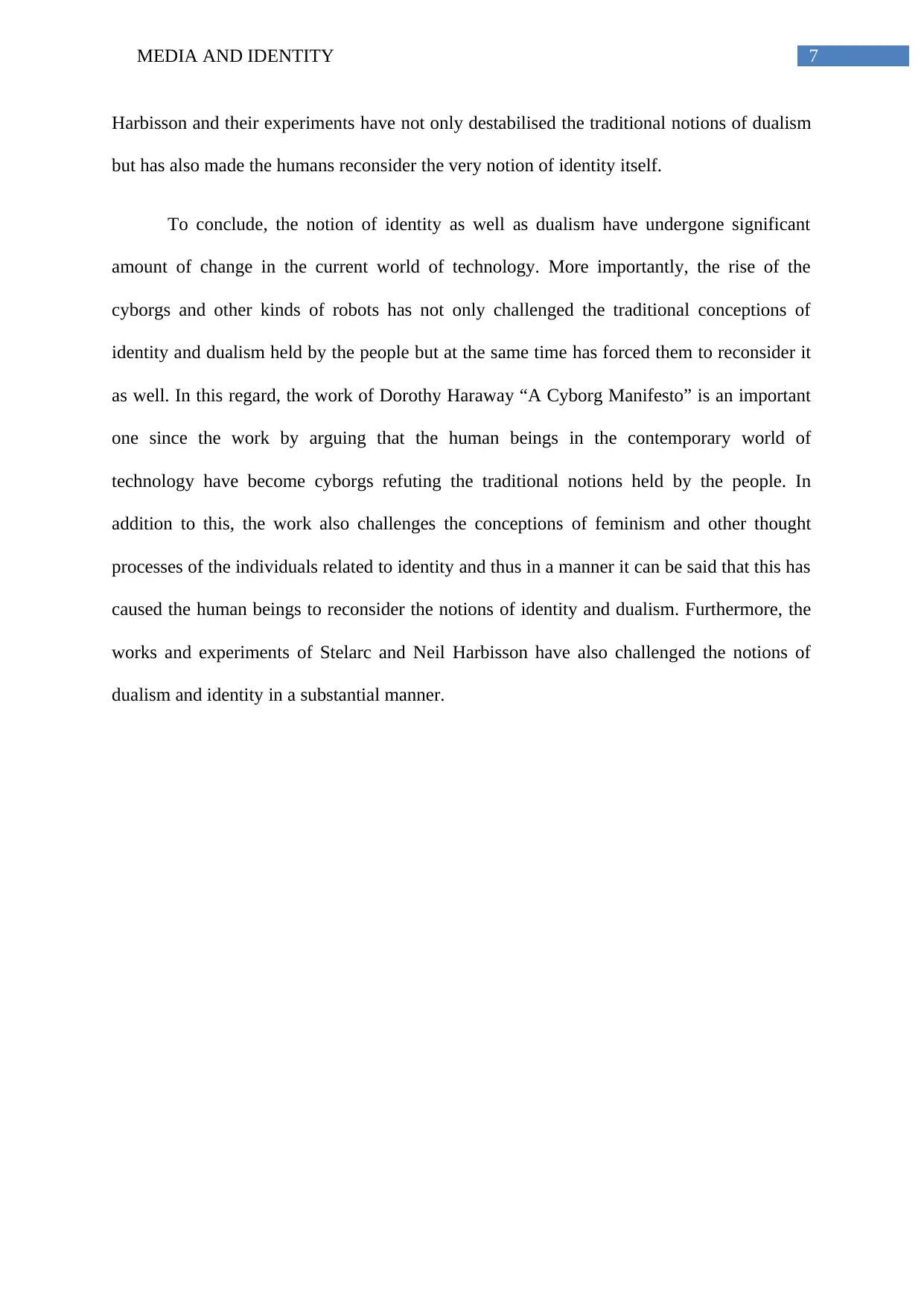
7MEDIA AND IDENTITY
Harbisson and their experiments have not only destabilised the traditional notions of dualism
but has also made the humans reconsider the very notion of identity itself.
To conclude, the notion of identity as well as dualism have undergone significant
amount of change in the current world of technology. More importantly, the rise of the
cyborgs and other kinds of robots has not only challenged the traditional conceptions of
identity and dualism held by the people but at the same time has forced them to reconsider it
as well. In this regard, the work of Dorothy Haraway “A Cyborg Manifesto” is an important
one since the work by arguing that the human beings in the contemporary world of
technology have become cyborgs refuting the traditional notions held by the people. In
addition to this, the work also challenges the conceptions of feminism and other thought
processes of the individuals related to identity and thus in a manner it can be said that this has
caused the human beings to reconsider the notions of identity and dualism. Furthermore, the
works and experiments of Stelarc and Neil Harbisson have also challenged the notions of
dualism and identity in a substantial manner.
Harbisson and their experiments have not only destabilised the traditional notions of dualism
but has also made the humans reconsider the very notion of identity itself.
To conclude, the notion of identity as well as dualism have undergone significant
amount of change in the current world of technology. More importantly, the rise of the
cyborgs and other kinds of robots has not only challenged the traditional conceptions of
identity and dualism held by the people but at the same time has forced them to reconsider it
as well. In this regard, the work of Dorothy Haraway “A Cyborg Manifesto” is an important
one since the work by arguing that the human beings in the contemporary world of
technology have become cyborgs refuting the traditional notions held by the people. In
addition to this, the work also challenges the conceptions of feminism and other thought
processes of the individuals related to identity and thus in a manner it can be said that this has
caused the human beings to reconsider the notions of identity and dualism. Furthermore, the
works and experiments of Stelarc and Neil Harbisson have also challenged the notions of
dualism and identity in a substantial manner.
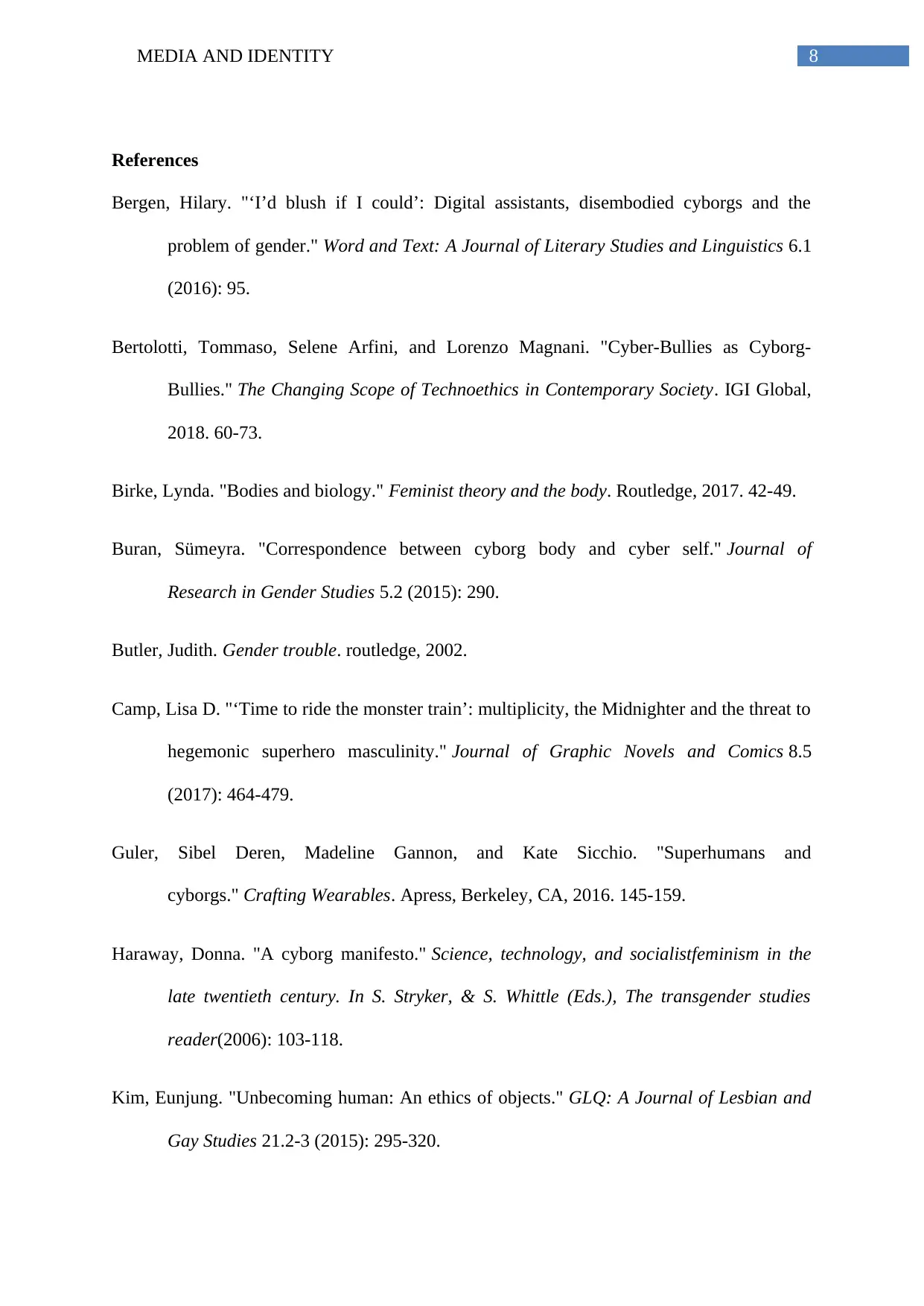
8MEDIA AND IDENTITY
References
Bergen, Hilary. "‘I’d blush if I could’: Digital assistants, disembodied cyborgs and the
problem of gender." Word and Text: A Journal of Literary Studies and Linguistics 6.1
(2016): 95.
Bertolotti, Tommaso, Selene Arfini, and Lorenzo Magnani. "Cyber-Bullies as Cyborg-
Bullies." The Changing Scope of Technoethics in Contemporary Society. IGI Global,
2018. 60-73.
Birke, Lynda. "Bodies and biology." Feminist theory and the body. Routledge, 2017. 42-49.
Buran, Sümeyra. "Correspondence between cyborg body and cyber self." Journal of
Research in Gender Studies 5.2 (2015): 290.
Butler, Judith. Gender trouble. routledge, 2002.
Camp, Lisa D. "‘Time to ride the monster train’: multiplicity, the Midnighter and the threat to
hegemonic superhero masculinity." Journal of Graphic Novels and Comics 8.5
(2017): 464-479.
Guler, Sibel Deren, Madeline Gannon, and Kate Sicchio. "Superhumans and
cyborgs." Crafting Wearables. Apress, Berkeley, CA, 2016. 145-159.
Haraway, Donna. "A cyborg manifesto." Science, technology, and socialistfeminism in the
late twentieth century. In S. Stryker, & S. Whittle (Eds.), The transgender studies
reader(2006): 103-118.
Kim, Eunjung. "Unbecoming human: An ethics of objects." GLQ: A Journal of Lesbian and
Gay Studies 21.2-3 (2015): 295-320.
References
Bergen, Hilary. "‘I’d blush if I could’: Digital assistants, disembodied cyborgs and the
problem of gender." Word and Text: A Journal of Literary Studies and Linguistics 6.1
(2016): 95.
Bertolotti, Tommaso, Selene Arfini, and Lorenzo Magnani. "Cyber-Bullies as Cyborg-
Bullies." The Changing Scope of Technoethics in Contemporary Society. IGI Global,
2018. 60-73.
Birke, Lynda. "Bodies and biology." Feminist theory and the body. Routledge, 2017. 42-49.
Buran, Sümeyra. "Correspondence between cyborg body and cyber self." Journal of
Research in Gender Studies 5.2 (2015): 290.
Butler, Judith. Gender trouble. routledge, 2002.
Camp, Lisa D. "‘Time to ride the monster train’: multiplicity, the Midnighter and the threat to
hegemonic superhero masculinity." Journal of Graphic Novels and Comics 8.5
(2017): 464-479.
Guler, Sibel Deren, Madeline Gannon, and Kate Sicchio. "Superhumans and
cyborgs." Crafting Wearables. Apress, Berkeley, CA, 2016. 145-159.
Haraway, Donna. "A cyborg manifesto." Science, technology, and socialistfeminism in the
late twentieth century. In S. Stryker, & S. Whittle (Eds.), The transgender studies
reader(2006): 103-118.
Kim, Eunjung. "Unbecoming human: An ethics of objects." GLQ: A Journal of Lesbian and
Gay Studies 21.2-3 (2015): 295-320.
⊘ This is a preview!⊘
Do you want full access?
Subscribe today to unlock all pages.

Trusted by 1+ million students worldwide
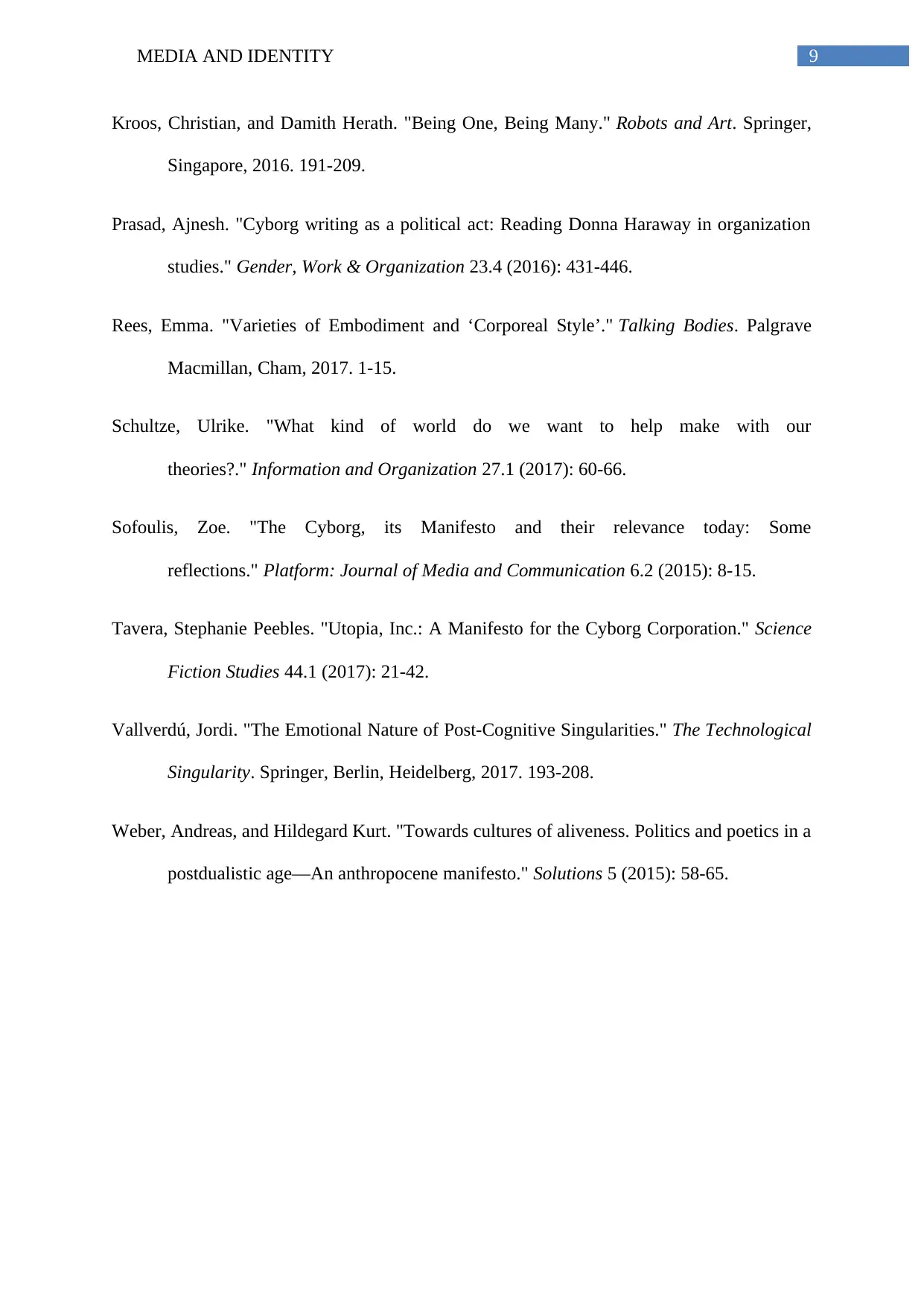
9MEDIA AND IDENTITY
Kroos, Christian, and Damith Herath. "Being One, Being Many." Robots and Art. Springer,
Singapore, 2016. 191-209.
Prasad, Ajnesh. "Cyborg writing as a political act: Reading Donna Haraway in organization
studies." Gender, Work & Organization 23.4 (2016): 431-446.
Rees, Emma. "Varieties of Embodiment and ‘Corporeal Style’." Talking Bodies. Palgrave
Macmillan, Cham, 2017. 1-15.
Schultze, Ulrike. "What kind of world do we want to help make with our
theories?." Information and Organization 27.1 (2017): 60-66.
Sofoulis, Zoe. "The Cyborg, its Manifesto and their relevance today: Some
reflections." Platform: Journal of Media and Communication 6.2 (2015): 8-15.
Tavera, Stephanie Peebles. "Utopia, Inc.: A Manifesto for the Cyborg Corporation." Science
Fiction Studies 44.1 (2017): 21-42.
Vallverdú, Jordi. "The Emotional Nature of Post-Cognitive Singularities." The Technological
Singularity. Springer, Berlin, Heidelberg, 2017. 193-208.
Weber, Andreas, and Hildegard Kurt. "Towards cultures of aliveness. Politics and poetics in a
postdualistic age—An anthropocene manifesto." Solutions 5 (2015): 58-65.
Kroos, Christian, and Damith Herath. "Being One, Being Many." Robots and Art. Springer,
Singapore, 2016. 191-209.
Prasad, Ajnesh. "Cyborg writing as a political act: Reading Donna Haraway in organization
studies." Gender, Work & Organization 23.4 (2016): 431-446.
Rees, Emma. "Varieties of Embodiment and ‘Corporeal Style’." Talking Bodies. Palgrave
Macmillan, Cham, 2017. 1-15.
Schultze, Ulrike. "What kind of world do we want to help make with our
theories?." Information and Organization 27.1 (2017): 60-66.
Sofoulis, Zoe. "The Cyborg, its Manifesto and their relevance today: Some
reflections." Platform: Journal of Media and Communication 6.2 (2015): 8-15.
Tavera, Stephanie Peebles. "Utopia, Inc.: A Manifesto for the Cyborg Corporation." Science
Fiction Studies 44.1 (2017): 21-42.
Vallverdú, Jordi. "The Emotional Nature of Post-Cognitive Singularities." The Technological
Singularity. Springer, Berlin, Heidelberg, 2017. 193-208.
Weber, Andreas, and Hildegard Kurt. "Towards cultures of aliveness. Politics and poetics in a
postdualistic age—An anthropocene manifesto." Solutions 5 (2015): 58-65.
1 out of 10
Your All-in-One AI-Powered Toolkit for Academic Success.
+13062052269
info@desklib.com
Available 24*7 on WhatsApp / Email
![[object Object]](/_next/static/media/star-bottom.7253800d.svg)
Unlock your academic potential
Copyright © 2020–2025 A2Z Services. All Rights Reserved. Developed and managed by ZUCOL.
